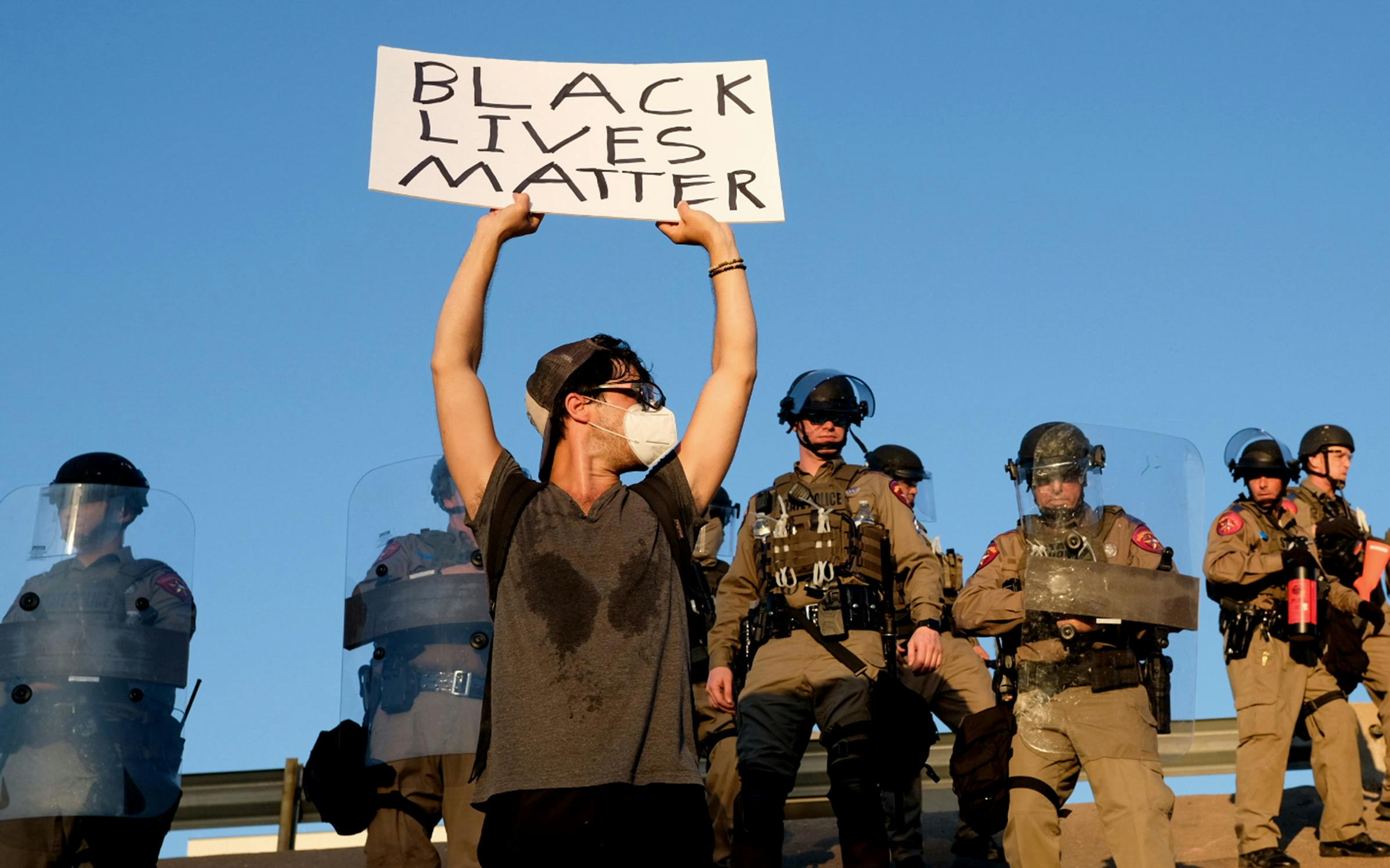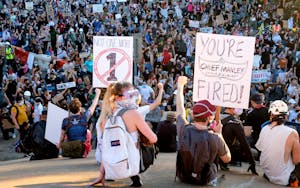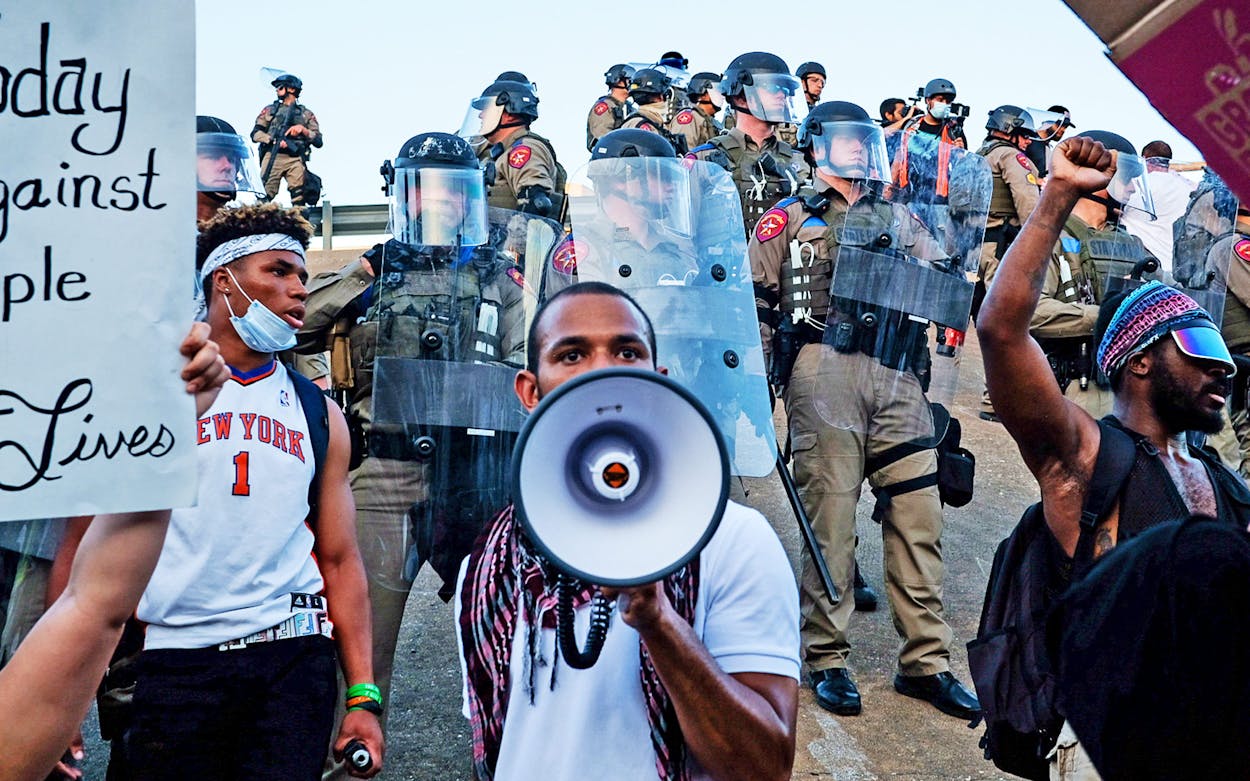At 6 p.m. on Thursday, police officers lined up along the front steps of the Austin Police Department headquarters. Their faces were clearly visible: they stood near a bin of helmets, but weren’t wearing riot gear like they had during protests in the days before. They were surrounded by barricades and a sea of protesters.
Organizers had scheduled Thursday’s demonstration specifically to confront the department because of its behavior at the week’s protests over racial injustice and the police killings of George Floyd in Minneapolis, Michael Ramos in Austin, and Breonna Taylor in Louisville, Kentucky. Last weekend, Austin police in riot gear fired projectiles into a crowd, maiming many and fracturing the skull of twenty-year old Justin Howell, an undergraduate at Texas State University who now is in critical condition. The Austin Office of Police Oversight has submitted 159 complaints to the department against individual police officers related to the week’s demonstrations—more than it did from 2015 to 2019. One man in the crowd Thursday night held a sign that read, “Which one of you shot Justin Howell?”
Earlier that day, the Austin City Council had held a virtual emergency meeting. During the public comment period, some of the weekend’s protesters spoke with raw emotion about their experiences. According to the Austin American-Statesman, the brother of a sixteen-year-old boy who was badly wounded after he was shot in the head with a beanbag round described “amid unrelenting sobs and cries” the seriousness of his brother’s injuries. He begged Austin police chief Brian Manley to stop using those projectiles. The city council members and the mayor all condemned the violence, and Manley said he’d ordered his officers to no longer use “beanbag” bullets on crowds.

When demonstrators arrived Thursday evening, no one was quite sure what to expect from law enforcement, who surrounded them on three sides: the Austin cops on the steps, state troopers on the hill leading to the Interstate 35 elevated highway, and a barricade of police cars with flashing lights blocking off the far north side of the frontage road.
Some protesters ventured up the concrete hill leading to I-35 the elevated highway, which splits through the heart of the city of Austin and stands as a reminder of its segregation. When they reached the top, they confronted the troopers, who had on heavy riot gear—long clear shields, black helmets with visors, and combat-ready accessories like shin pads and bulletproof vests. Some held batons and some held rifles.
“Why are you in riot gear?” the protesters said in unison. “We don’t see no riot here!” Then they turned their backs on the troopers and shouted through their megaphones at the larger crowd in the intersection below. “Let’s do it for their families, for everyone who’s been killed by those f—ers up there,” one said, pointing to the troopers at the top of the hill.
“We want justice, the right way!” #austinprotests pic.twitter.com/J2CucN03E9
— Leif Reigstad (@LeifReigstad) June 5, 2020
A young black protester with a megaphone turned to the crowd below, urging them to kneel down together and raise their fists in solidarity. At first, only some of the crowd did. The young man asked again. The crowd dropped to its knees.
Moments later, the troopers formed a line near the highway guardrail. They methodically marched down the steep concrete decline alongside I-35, shields raised, forcing the protesters backward. Chalk spotted the pavement on which the troopers marched; one cluster of troopers stood directly above a message that read “Killers.”
There was shouting on the hill, to the right, close to the underpass. A few protesters had broken from the group and began jawing at the troopers, threatening a serious physical confrontation. One young black man with a megaphone stepped between the group of protesters and the riot police. He shouted at the protesters, who were stubbornly holding their ground on the concrete hill, and implored them to peacefully walk down. “Come on y’all,” he said to the crowd. “It’s about peace, it’s about being heard. The moment we divide ourselves is the moment we divide our message.”

The man and his friends physically restrained and talked down several white men among the group of protesters who seemed ready to charge at the line of law enforcement.
The troopers slowly continued their forward assault, and the protesters slowly retreated off of the hill. The police seemed uninterested in advancing much farther—they held the hill, keeping the highway traffic flowing. A thin line of protesters formed a human chain—and remained on the frontage road, face-to-face with the troopers. Others occupied the streets. The protesters with megaphones stood up on a line of plastic barricades in the middle of the intersection and told the crowd to turn away from the heavily armored troopers and police, and march instead to the state capitol. Most of the protesters followed, but some remained.
It de-escalated the situation at APD headquarters, and a peaceful, almost celebratory mood took over. Two women twirled a pair of rainbow flags in the intersection, to the beat of a bongo drum, as a small circle of protesters watched. Under the overpass, a pastor on a hover board was rapping about Jesus over a loudspeaker. Some protesters walked among the hungry crowd, offering water and hand sanitizer, and toting carts with free snacks, like apples, bananas, and Doritos. The scents of BBQ smoke and marijuana sweetened the air.
A few Austin cops, armed with orange rifles, relaxed their stiff postures and leaned casually along the railing of I-35. Roughly fifteen feet below them, state troopers still held the line at the bottom of the hill. And the thin line of protesters still stood peacefully across from them, face-to-face; one of them held an American flag.

Hours passed, more protesters arrived—and with them more cops—but there were no new confrontations. There were more rounds of chanting, “We don’t see a riot here, why are you in riot gear?”
Around 10:15 p.m., the troopers on the hill did something that few expected: they walked single file down the decline, headed back across the street to the parking garage, and left. Most of the protesters stayed. So did most of the Austin police, who moved down to maintain the line at the bottom of the hill.
Across the intersection, along the front steps of APD headquarters, some cops were leaning over the border of barricades to have lengthy conversations with some of the protesters. The police on the steps hadn’t put on riot gear.
Chants continued to break out among the crowd late into the night. Protesters were still just as angry about police brutality as they had been during that fraught moment on the hill, but the tension was nearly gone. The music played on. The thin line of protesters along the bottom of the hill never wavered. According to APD, there were no arrests.
The rapping pastor on the hover board periodically shouted into his microphone, reminding the crowd that “we’re all going home safe tonight.”
- More About:
- Politics & Policy
- Black Lives Matter
- George Floyd






